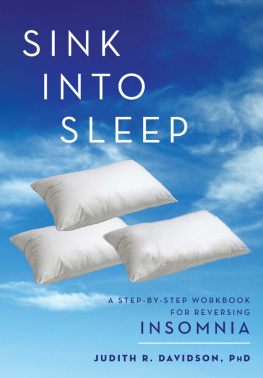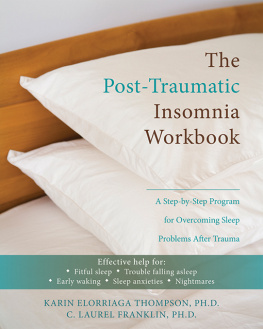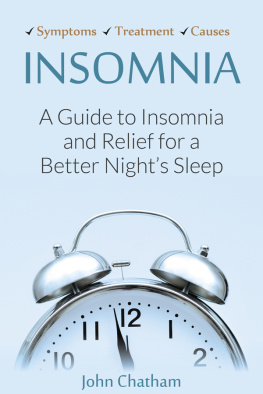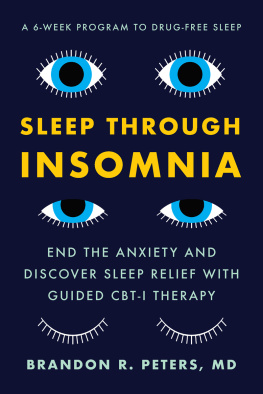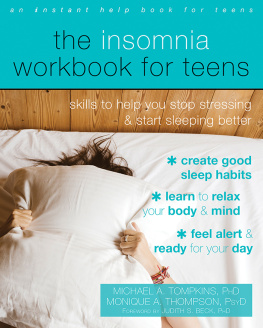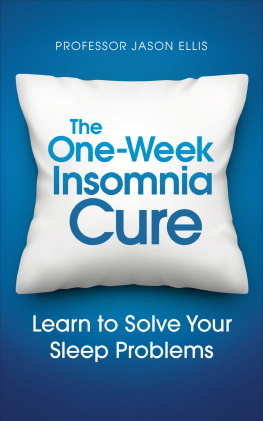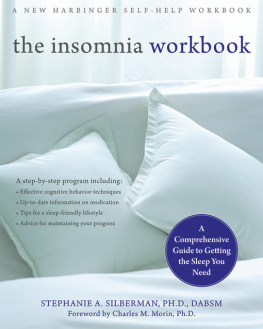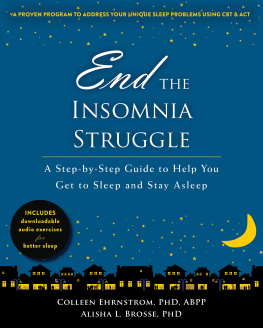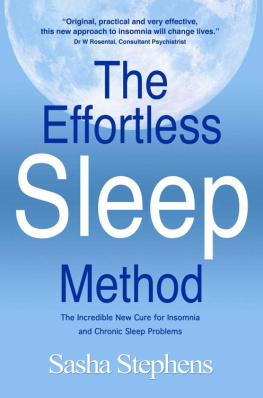SINK INTO SLEEP
A Step-by-Step Workbook for Reversing Insomnia
Judith R. Davidson, PhD, CPsych

I have worked with Dr. Judith Davidson as a colleague, fellow educator, and researcher in sleep for 12 years, on a wide range of sleep issues, including the subject of this book, insomnia. Her training in clinical psychology complements mine in physiology, and makes it particularly enjoyable to collaborate with her on activities such as team-teaching an undergraduate and a postgraduate course in sleep. Judith never rests on the topic of sleep, and continues to deepen her knowledge in the field by collaborating with international experts such as Dr. Charles Morin, knowledge that she shares with her peers, patients, and students. It's been a pleasure to work with, and learn from, Judith over the years.
Judith's extensive clinical and research experience has enabled her to provide insomnia sufferers with a practical guide to sleeping well. Insomnia is a significant burden to individuals, their family and society, affecting approximately 40% of adults 3 or more times a week. Her new book, Sink Into Sleep, encapsulates that knowledge in her own gracious style, and can teach insomnia sufferers powerful techniques for overcoming their own late night struggles.
Judith begins by clearly and succinctly describing the biology underlying sleep processes, giving the reader the basic understanding that is necessary to master the techniques of successful sleep. Age, being female, and genetics are known risk factors for insomnia, and each of these topics is discussed in this book. She also addresses key influences, such as the impact of various conditions including chronic pain, depression, cancer, and heart disease, as well as breathing disorders and movement disorders. Although the book focuses on nonpharmacological treatment for insomnia, she also outlines the pros and cons of sleep medications.
From laying the foundation by describing biological sleep processes, Judith guides the reader through 6 steps to solid sleep. The techniques she describes are grounded in research and evidence-based outcomes. The tools that she provides enable readers to self-monitor and measure their weekly progress toward optimizing their sleep. In one of her anecdotes, a man describes regaining sleep as being tapped by a velvet hammer: Judith's calm, considered approach allows sufferers to beat the desperate frustration of seemingly perpetually elusive sleep.
For once, I am grateful when a book puts me to sleep, and I hope this book Sink Into Sleep does the same for you.
Helen S. Driver, PhD, RPSGT, DABSM
Past-President, Canadian Sleep Society
www.canadiansleepsociety.com
Sleep Disorders Laboratory
Kingston General Hospital and
Department of Medicine
Queen's University
Kingston, Ontario, Canada
M y career began in a sleep lab. I was hired in 1981 by Dr. Harvey Moldofsky to work in the sleep clinic at Toronto Western Hospital. A year earlier, I had taken a fascinating course, called The Psychology of Sleep, taught by Professors Alistair MacLean and John Knowles at Queen's University. This course inspired me to apply to every sleep laboratory I could locate. At that time, sleep labs were few and far between, and so I was fortunate to land a job in one.
I was involved in all of the day and night activities of the sleep lab, which included hooking people up with electrodes and putting them to bed so that we could see if they had a sleep disorder such as sleep apnea, periodic limb movements, narcolepsy, or unusual behaviors during sleep. We also did research studies with volunteers who agreed to have their brain waves and blood studied so we could look at the effects of sleep and sleep deprivation on the immune system. I realize now just how much I learned back then, in that lab. That experience turned out to be my stepping stone to many more years in the ever-expanding world of the science of sleep.
I have never strayed far from sleep. My master's thesis focused on the effects of sleep deprivation and naps on people's performance and mood. My PhD thesis was done with cancer patients. I surveyed 1,000 people with cancer to find out what types of sleep problems they experienced. About one-third of them reported sleep difficulty that occurred most nights and that affected their daytime functioning. By matching up the types of insomnia and the reported reasons for the sleep difficulty to the best available techniques, I developed a Sleep Therapy program for cancer patients. The program worked well to restore people's sleep; it also helped to reduce their fatigue. This was very encouraging. I then had the privilege of being a postdoctoral fellow with Dr. Charles Morin, a world leader in the field of insomnia, in Quebec City. Following that fellowship, I had a private psychology practice for a few years. People of all descriptions and health circumstances were coming for help with their insomnia. More recently, I have been providing Sleep Therapy in a family practice setting to patients who often have medical or emotional conditions.
Over the years it has become very clear to me that certain techniques reverse insomnia, regardless of whether we have cancer, chronic pain, heart disease, depression, anxiety, or any other human ailment. Dealing with insomnia when you have other health issues is just a variation on dealing with insomnia when that is your only problem.
These days, I focus on connecting people who have insomnia to effective treatments so they can sleep well, and so they know how to maintain their good sleep. A big part of this is trying to boost access to effective treatments, through the training of professionals, and spreading the word to the community at large, so that more people know about the techniques. It is why I have written this book. It is my sincere hope that this book provides you with what you need to sleep well. Be encouraged, even if you have had insomnia for many years, that the techniques that I will show you have been scientifically studied for years and they are effective for improving sleep. In fact, together, they are the best treatment for persistent insomnia.
One of the main concepts of this book was inspired by an encounter I had years ago with a tiny, elderly man at a cancer center. When I asked about his sleep, he told me that during his treatments for cancer, he had weeks and weeks of sleepless nights. However, just after the series of treatments ended, a wee angel had swept down and knocked him tenderly on the head with a velvet hammer, thus restoring his sleep from that point onward. I will not forget the twinkle in his eye and the smile that stretched from ear to ear. Sleep had found him. Indeed, sleep is something that we cannot actively search for, because in doing so, it evades us. Trying too hard to control sleep pushes it away. Rather, we have to make the circumstances conducive to sleep, and then relax, involve our minds in other things, and be delighted when it comes. This is the velvet hammer concept. The techniques in this book are designed to let your internal sleepwake rhythms operate naturally, without interference. By relying on them, rather than over-thinking or trying to control sleep, you too will find that something changes, allowing the velvet hammer of sleep to descend.
SINK INTO SLEEP
A Step-by-Step Workbook for Reversing Insomnia
I am fortunate to have had encouragement and assistance from many people. A big smile and my heartfelt thanks go to Brenda Bass and Glenyss Turner, who both devoted hours to reading the book and offering helpful suggestions. Glenyss also entered and checked all the references. I am grateful to both of you for sharing your wisdom and talents. I wish to acknowledge the support of Queen's University and Queen's University Faculty Association who provided a grant from the Scholarly and Professional Development Fund when I began this project. Thank you to the following people for reviewing sections of the book: Ada Sulcs, Jim Willis, Bruce Beninger, Helen Driver, Peet de Villiers, Richard J. Beninger, Alice Layton Falchetto, Jane Lapointe, Hugh Ryan, Barbara Muirhead, Theresa Krug, Cathy Hollington, Marcia Bryant, Bonnie Ramsay, Clint Flood, and Sylvia Bass-West. You each know what you contributed and I appreciate every little bit. Eric Brousseau's skillful work on the design of the forms allowed me to pilot test them to make sure they worked for readers. Finally, I've benefited from the continued stability and occasional frivolity provided by my running buddies. Thank you everyone.
Next page
